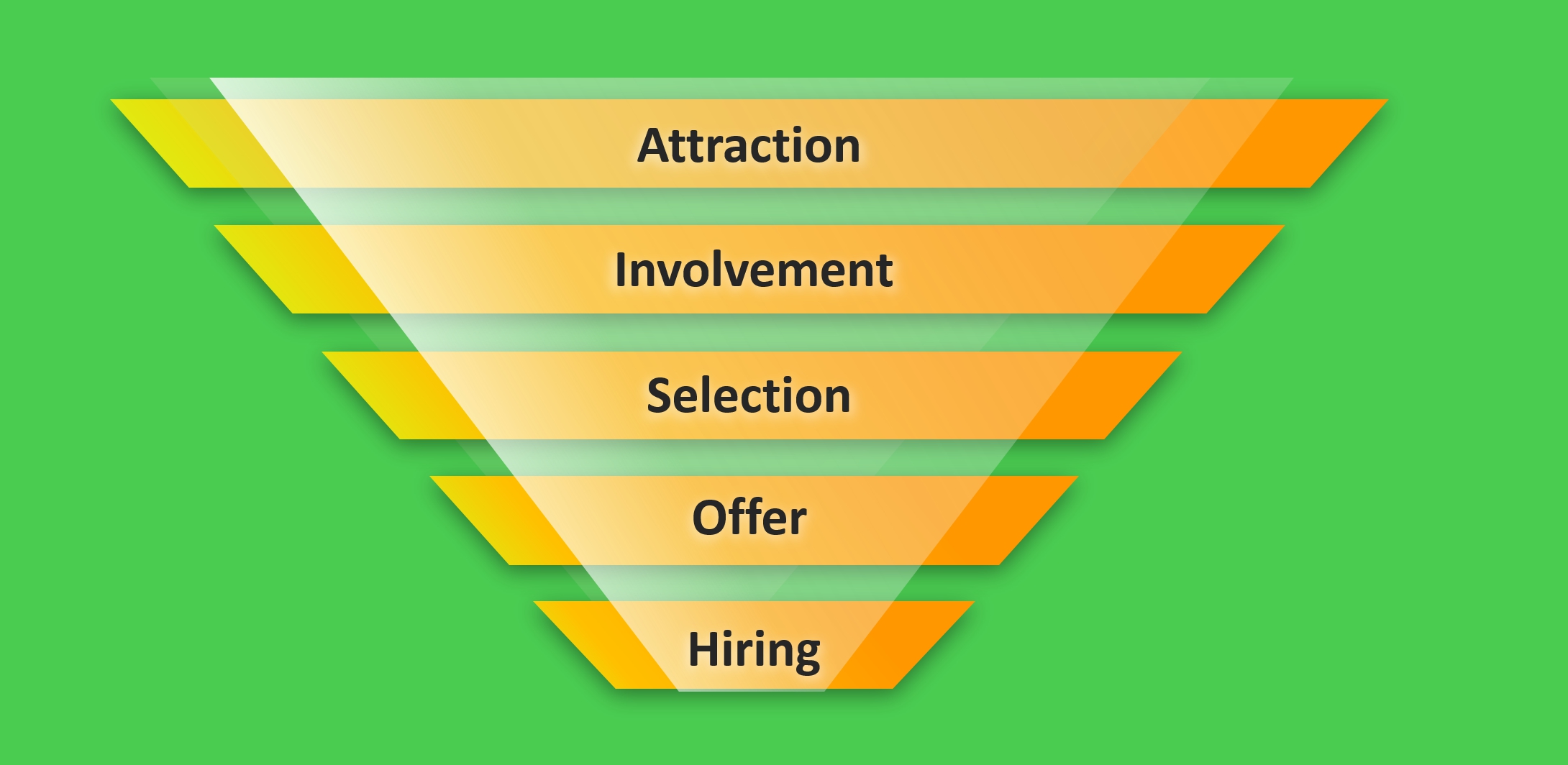The correct recruiting funnel, or how to build a route for the best candidates
The main task of the recruiter is to attract the maximum number of candidates, and then gradually select them, choosing the best specialists to fill the vacancy. There are several ways to do this, but one of the most effective and versatile is the recruitment funnel. CleverStaff specialists will tell you more about what it is, what stages it includes, and what nuances may arise in the process of work.

What is a recruitment funnel?
The concept of a funnel came to HR from marketing. Marketers use this technique to “guide” the client through all stages, starting from “what is it?” to “I bought this and will buy again!”. In recruiting and staff selection, it works in a similar way.
It is important to understand that a vacancy is de facto the same commodity as any other. There is supply and there is demand. The task of the recruiter is to “sell” the vacancy. That is, to make sure that the maximum number of specialists find out about the available vacancy, become interested in the company and send their resume.
A recruiting funnel is a recruiter’s tool that allows you not only to attract as many people as possible, but also to control statistics. You can find out how many people are interested in the vacancy and how many have passed to the next stage. As a rule, only the most interested people reach the end, and the task of the recruiter is to select the most qualified, motivated and satisfying the requirements of the vacancy.
Why a recruiting funnel is needed?
The recruiting funnel will be useful for recruiters who work with a large number of resumes. This method is appropriate primarily for mass hiring of employees or for working with vacancies where there is a large response. For small businesses, such recruitment is not very effective.
The funnel helps to solve the following tasks:
- improvement of selection efficiency by selecting-out unenthused candidates;
- monitoring of effectiveness of the vacancies of various types. You can experiment with texts and approaches;
- forecasting the terms of vacancy closing;
- conversion monitoring;
- possibility to make adjustments to the search process. For example, if at the first stage you see a small response, then you can use other methods;
- possibility to identify problems with the methods used. For example, if many candidates are selected-out during the negotiation stage, this point needs to be studied.
The funnel should display the number of jobseekers at each stage. In addition, it is recommended to funnel each type of vacancy if you use different methods and approaches. In this case, you can find the type of vacancy that works most effectively for the selection of personnel for a particular position. It will help you today and in the future.
Hiring funnel stages
The recruiting funnel can amount to a different number of stages. As a rule, there are 5 primary ones. However, you can expand the hiring funnel, depending on the specifics of the company for which you are looking for specialists. For example, an interview with a team lead, security check, cold selection, online testing, ets. Let’s analyze the primary ones.

- Attraction
The initial stage in which the manager needs to attract candidates. At this stage, you post vacancies in various sources and promote them. The key task is to convey information that the company needs an employee and to provoke interest of the candidates for the position.
For jobseekers to be really interested in the vacancy, it is important to work on the company’s brand and provide as much information as possible. Clients will search for information before applying for a job, and they should get it. Social media is an important source for this, as according to the Pew Research Center, up to 35% of jobseekers first look for a potential employer’s corporate account before applying. Also experiment with the description, use sales texts in vacancies, track statistics from different sources.
- Involvement
At this stage, there are potential candidates who already show a substantive interest in the vacancy and are ready to respond. Here, it is important to provide the candidate with all the necessary information so that the most interested send their resumes.
The best way to provide information is to prepare the FAQ. Collect answers to frequently asked questions so you do not have to answer the same questions over and over again. It is also recommended to develop a convenient way of communication. For example, chatbots work well. With their help, you can automate the process of answering questions.
Set up a notification system for new resumes. Keeping the application process simple is critical, as 60% of candidates (according to CareerBuilder) withdraw from submitting a resume if the process is long and complicated. It is also better to set up an automatic response to resumes. Feedback is very important for candidates, and the sooner it comes, the better.
- Selection
The involvement stage is completed at the resume submission stage, and now the recruiter’s work is to select the most suitable candidates. After this stage, the majority of jobseekers are eliminated, and only those people who satisfy the requirements to the uttermost remain.
During the selection, various tests are carried out, and it is important to make the process interesting. For example, use gamification and conduct selection in the form of a game. You can use situational tests, workflow overview videos, etc. During the selection, evaluate not only basic skills, but also soft skills. Even if the candidate lacks professional skills, this can be taught, but not everyone is able to join the team and successfully communicate with colleagues.
- Offer
After you have selected a suitable number of candidates, it is time to negotiate the terms. Your offer will not suit everyone, and at this stage, another part of the applicants will be eliminated. Those who are suitable for filling the vacancy will remain, and at the same time agree with the stipulated conditions, or their proposals may be accepted by the employer.
At the interview stage, it is better to find out what is a priority for a candidate, and based on this, form an offer. Jobseekers may be interested in prospects, further career growth, working conditions, etc.
- Hiring
Hiring is the final stage of the funnel. And the fact that an employee started working does not mean that the funnel is closed. It is not a fact that he will stay at the workplace for more than 1 month. And you need to help the newbie.
First of all, the new employee should immediately be provided with everything needed for work. Be sure to introduce the employee to the team, introduce him, conduct onboarding. It is important to provide maximum assistance with onboarding so that the employee remains in the company and actively participates in its development.
Response to a vacancy is a key indicator
The first indicator that needs to be analyzed in the recruitment funnel is the response, i.e. the number of resumes you received after posting a vacation. And this is the first parameter from which further calculation of the efficiency indicator is conducted.
It is necessary to analyze responses for each source. For example, if you use job search websites – analyze each of them, if social networks – measure the results for each platform. If you do this, you’ll have a baseline of analysis for each source and find out where the most candidates come from. It is better not to use sources that do not give results – this is a waste of time, effort and money.
Another important aspect is to experiment with vacancy formats, measuring responses for each option. This will help you figure out which format attracts the most audience. Further, the vacancies that attract the most responses are placed on the sources that give the best results.
How to analyze a candidate funnel properly?
It is important to analyze the candidate funnel correctly in order to know exactly how effective your recruitment and recruitment campaign is. For this you need to:
- prepare a template for analysis,
- indicate each stage,
- measure how many people came at the beginning, and how many passed each stage,
- calculate the percentage of conversion – what percentage of people passed each stage.
It is recommended to analyze the funnel from the stage of obtaining or from the stage of selecting a resume. Analyze for each source separately – how many people who corresponded your requirements came from various sources. It is important to indicted in the funnel the number of resumes received, the number of interviews (telephone and face-to-face), the number and percentage of hired employees, and the number and percentage of those not hired. It is also important to indicate the failure causes.
How to improve funnel metrics?
It happens that recruiting turns out to be ineffective, and the funnel just allows you to identify problems quickly. By controlling recruiting in terms of job funnel, you can make timely adjustments by changing some element. For instance:
- Experiment with vacancies formats. It is better to immediately prepare several options and test them. If you use one format and get a few resumes, try to changing it.
- Simplify the application process. Perhaps the small number of resumes is due to the complexity of their submission. For example, you can make an automatic form that you can fill up in a few clicks and attach a resume. The fewer stages pass before the applicant submits a resume, the better.
- Make a personal rating. When analyzing resumes, at first, select the most suitable candidates and schedule an interview with them first.
- Get maximum information about candidates’ priorities and mark them in advance. This will help stress correct topics when preparing an offer.
It is always important to monitor the statistics, analyze it and be flexible – this will help to adjust the process of searching and selecting candidates.
Professional software will increase the applicant funnel efficiency
The process of searching, selecting candidates and maintaining statistics is routine. If you do it manually, you can make mistakes that can make the statistics incorrect. To avoid this routine and avoid mistakes, use professional software. Special programs for recruiters and HR can make funneling, maintenance and analysis more effective.
For example, the Cleverstaff ATS system demonstrates good funneling abilities. The service has the following benefits:
- ability to draw up diagrams that clearly reflect effectiveness of each stage,
- ability to calculate relative and absolute conversion,
- accounting for each candidate,
- automatic interest calculation, one-click candidate data management,
- fast and convenient unloading of reports.
Thus, proper automation will make the work of searching and recruiting personnel more efficient and flexible, significantly increasing efficiency of the applicant funnel and recruiting stages in general.
